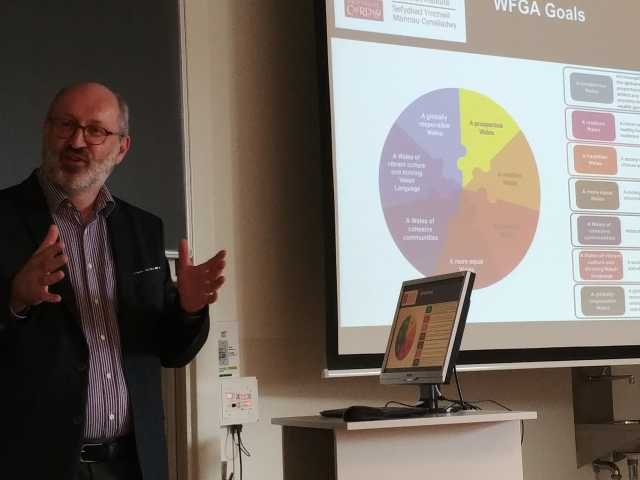Wales, an experiment in governance for sustainability and well-being

Matthew Quinn (Sustainable Places Research Institute at Cardiff University, Distinguished Visiting Fellow) URSI lunch seminar, Tuesday May 22, 2018
Sustainability: a guiding principle
How does the Welsh government move towards a more sustainable society? The so-called “Well-being of Future Generations Act 2015” (WFGA) intended to carry out sustainable development as a central principle in Welsh legislation. Briefly, the WFGA operates on basis of seven goals, five ways of working, and structures (see the WFGA factsheet for the exact goals, ways and stuctures).
Using sustainable development as central principle for goals, ways of working and structures immediately raises all sorts of questions: how is sustainability defined and operationalized, what mode of governance is employed, and does the act make an actual impact on society? Matthew Quinn, previously working as a civil servant and now an academic in the field of sustainability, planning and environment presented his work in progress on how the WFGA was received and how it can be understood from theoretical perspectives and views of governance.
Plural interpretations
“Bullshit piled high and overhung with impossible dreams, interwoven with outright lies”. This quote from “Jac o’ the north blog” provides one of the views on the WFGA, suggesting that the traditional Welsh culture is undermined by this act by English hippies. An entertaining, yet serious quote: isn’t sustainability supposed to connect to local desires and needs? Critique can also be found from other than local sources. For example, CBI Wales, the UK’s premier business organization that voices firms at all spatial levels to policymakers, calls the WFGA “a dog’s dinner”, coming from an argument against big government. Of course, the act would not survive without those in favour of it, such as RSPB (nature organization), the Cair and Repair Cymru (a charitable housing body) and the Carnegie UK Trust (trust that improves wellbeing). They call it respectively “a cultural shift”, “ambitious, pioneering and, by any stretch of public policy making imagination, a phenomenal piece of statutory drafting from legislature in its infancy… it must not fail”, and “a real opportunity to make a difference to the wellbeing of local places and local people”. The perspectives co-exist, according to Quinn, due to competing views of governance.
Governance in threefold
Three views compete, Quinn argues. First, a managerial view emphasizes (among others) government control, sectoral structures, targets, reporting and evaluation, and derives its legitimacy from a representative democracy. Second, an enabling view emphasizes a supporting role for government regarding long-term goals, open process, multiple actors, an inclusive approach and derives legitimacy from a participative democracy. Finally, a market view stresses market-operation, price signals, market failures, and derives its legitimacy from hegemonic position of economic competitiveness. What happens then, is a conflict between managerial and market views stressing monitoring and accountability versus enabling views, stressing co-creation and co-production.
Dilemmas
In the discussion, various dilemmas that build on these views on sustainability came to light: the main dilemma comprised a contrast between legislation being small-scale/specific versus large-scale/general. If the WFGA is so general to encompass sustainability in just a few goals, methods and structures, can it then at all be truly sustainable? Doesn’t sustainability require local trade-offs that are impossible to generalize on an aggregated level? Indeed, what can be seen is a conflict. The managerial view emphasizing control requires operationalization of sustainability: high-level goals must be translated to indicators. Then, even when formulated according to the SMART criterium, these indicators turn “dumb”, as they are mostly proxy measures, and are often sectoral. Then, these general indicators can never fit the small-scale specific trade-off that a local situation requires. Consequently, the discontent mentioned earlier appears unavoidable. Additionally, issues of implementation gaps or “box-checking” occur.
A second dilemma relates to the degree to which the legislation is bottom-up versus top-down / hierarchical. Whereas an enabling view would especially favours a more bottom-up approach, a managerial view especially favours a more hierarchical view. It is clear from the plural interpretations that the various actors would benefit differently from these approaches.
Towards sustainability governance
Quinn finished his talk with a call for knowledge: if indeed these dilemmas occur in establishing governance for sustainability, then what perspectives can help in bridging these dilemmas? In all, the seminar raised interesting perspectives and questions on governance of sustainability, governance for sustainability, and maybe sustainability of governance itself.

